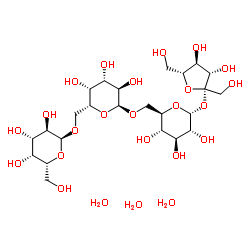Lupeose

Lupeose structure
|
Common Name | Lupeose | ||
|---|---|---|---|---|
| CAS Number | 54261-98-2 | Molecular Weight | 720.623 | |
| Density | N/A | Boiling Point | N/A | |
| Molecular Formula | C24H42O21 | Melting Point | 110 °C(dec.) | |
| MSDS | USA | Flash Point | N/A | |
|
D-chiro-inositol affects accumulation of raffinose family oligosaccharides in developing embryos of Pisum sativum.
J. Plant Physiol. 168(4) , 352-8, (2011) Developing garden pea embryos are able to take up exogenously applied cyclitols: myo-inositol, which naturally occurs in pea, and two cyclitols absent in pea plants: d-chiro-inositol and d-pinitol. The competition in the uptake of cyclitols by pea embryo, ins... |
|
|
Improved evaporative light scattering detection for carbohydrate analysis.
Food Chem. 180 , 265-71, (2015) Optimization and validation of evaporative light scattering detector (ELSD), aided by response surface methodology (RSM), has been developed for the liquid chromatography analysis of a wide molecular weight (MW) range of carbohydrates, including polysaccharid... |
|
|
Functional analysis of family GH36 α-galactosidases from Ruminococcus gnavus E1: insights into the metabolism of a plant oligosaccharide by a human gut symbiont.
Appl. Environ. Microbiol. 78(21) , 7720-32, (2012) Ruminococcus gnavus belongs to the 57 most common species present in 90% of individuals. Previously, we identified an α-galactosidase (Aga1) belonging to glycoside hydrolase (GH) family 36 from R. gnavus E1 (M. Aguilera, H. Rakotoarivonina, A. Brutus, T. Giar... |
|
|
Purification and characterization of Aspergillus terreus α-galactosidases and their use for hydrolysis of soymilk oligosaccharides.
Appl. Biochem. Biotechnol. 164(7) , 1111-25, (2011) α-Galactosidases has the potential to hydrolyze α-1-6 linkages in raffinose family oligosaccharides (RFO). Aspergillus terreus cells cultivated on wheat bran produced three extracellular forms of α-galactosidases (E1, E2, and E3). E1 and E2 α-galactosidases p... |
|
|
Nutritional potential of rice bean (Vigna umbellata): an underutilized legume.
J. Food Sci. 78(1) , C8-16, (2013) Rice bean, a less known and underutilized legume, has emerged as a potential legume because of its nutritional potential. The nutritional quality of rice bean is higher as compared to many other legumes of Vigna family. In the present study, 16 diverse rice b... |
|
|
Levansucrase and sucrose phoshorylase contribute to raffinose, stachyose, and verbascose metabolism by lactobacilli
Food Microbiol. 31(2) , 278-84, (2012) Raffinose family oligosaccharides (RFOs) in food are considered anti-nutritional factors. This study elucidated the role of α-galactosidase (α-Gal), levansucrase, and sucrose phosphorylase for conversion of RFOs by lactobacilli. Quantification of gene express... |
|
|
Amborella trichopoda, plasmodesmata, and the evolution of phloem loading.
Protoplasma 248(1) , 173-80, (2011) Phloem loading is the process by which photoassimilates synthesized in the mesophyll cells of leaves enter the sieve elements and companion cells of minor veins in preparation for long distance transport to sink organs. Three loading strategies have been desc... |
|
|
Protein recovery from enzyme-assisted aqueous extraction of soybean.
Biotechnol. Prog. 26(2) , 488-95, (2010) Enzyme-assisted aqueous oil extraction from soybean is a "green" alternative to hexane extraction that must realize potential revenues from a value-added protein co-product. Three technologies were investigated to recover protein from the skim fraction of an ... |
|
|
Reduction of α-galactoside content in red gram (Cajanus cajan L.) upon germination followed by heat treatment.
J. Sci. Food Agric. 91(10) , 1829-35, (2011) Red gram (Cajanus cajan L.) is an important crop for human and animal nutrition. However, raffinose family oligosaccharides present in red gram seed hinder its consumption as it is not digested by normal human carbohydrases and is further fermented by intesti... |
|
|
Reduction of soybean meal non-starch polysaccharides and α-galactosides by solid-state fermentation using cellulolytic bacteria obtained from different environments.
PLoS ONE 7(9) , e44783, (2012) Soybean meal (SBM) is an important protein source in animal feed. However, the levels of SBM inclusion are restricted in some animal species by the presence of antinutritional factors (ANFs), including non-starch polysaccharides (NSPs) and α-galactosides (GOS... |